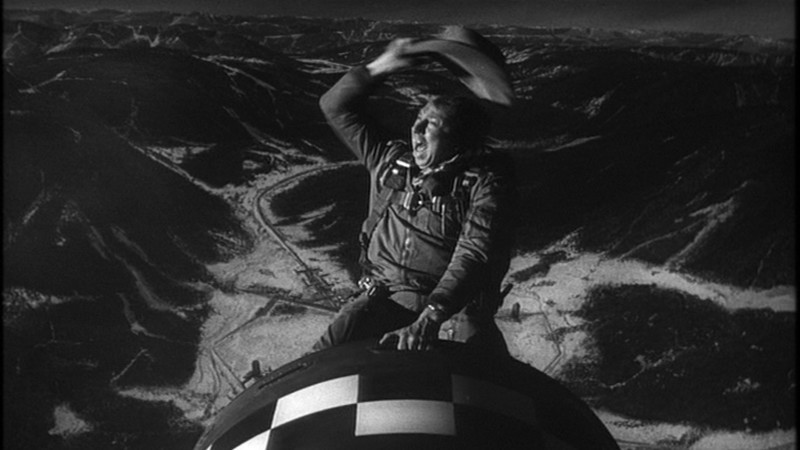
If Ronald Reagan’s presidency yearned for the age of Norman Rockwell, Donald Trump’s reaches to the era of “Dr. Strangelove.” Based on a speculative science-fiction novel, Red Alert by Peter George, “Dr. Strangelove or: How I Learned to Stop Worrying and Love the Bomb” is about a paranoid US Air Force General who sets into motion a Nuclear attack against the USSR. Collaborating with Peter George and satirist Terry Southern, Stanley Kubrick adapted the film into a “nightmare comedy,” starring Peter Sellers, George C. Scott and Sterling Hayden. Satirizing cold war tension, Kubrick’s darkly prescient satire about America’s military fixation maintains its horrifying relevance as President Trump and Kim Jong-Un engage in a Nuclear power struggle played out on a social media stage.
In The Ways of Seeing, the late John Berger argued that the legacy of Western Art is the legacy of those in power. Only the most powerful people could commission an artist and have it reflect on their wealth and influence. A king might be bathed in jewels but it was more likely that an artist would reflect on the King’s strength by portraying him in a military outfit. Forcing viewers to their knees, it was common for these portraits to be painted from a low angle so that you had no choice but to look up to the King.
As PR firms and marketers play an increasingly large role in shaping the White House, the language of power has barely changed since the era of Kings and Queens. In many ways, Trump continues a long established tradition of demonstrating military strength but even so, few presidents have been as optically pro-war as President Trump. Take, for example, Trump’s end of year review that summarizes his first year in office. Prefacing Trump’s list of accomplishments, a twenty-five-second montage sets the video’s tone in a quick-fire edit of jet fighters, soldiers, and Trump. Edited to the beating drum of a war call, the sequence builds to a crescendo that insinuates Donald Trump as a strong military leader.

“Dr. Strangelove” opens with credits over shots of refueling aircrafts, a darkly funny allusion to military power as a perverted coitus. With this romantic introduction, by the time we cut to Genera Ripper (Hayden) setting into motion an attack on the USSR, the camera’s comically low angle feels more funny than threatening. Kubrick subverts the imagery of power through aesthetic juxtapositions and by presenting his military leaders as sex-obsessed megalomaniacs. Inadvertently, Trump evokes this comedic whiplash too by painting himself as a strong leader only to contradict it with a jingoistic tweet or a fake news rant.
Wildly propagandistic and a great example of the military enthusiasm that Kubrick satirizes in “Dr. Strangelove,” the year-end video is Trump’s hawkishness in its mildest form. The video is troubling in how it attempts to normalize the military-industrial complex but is not necessarily a huge departure from established American political audiovisual rhetoric. Trump’s year-end video may be the kind of imagery officially endorsed by the campaign but is hardly the most representative. Trump’s Americana is “best” expressed through memes and art created by his supporters who turn to photoshop and create their own characterizations of Trump’s power by employing over the top comic representations of strength and violence. While not officially associated with his administration, since the early days of his campaign, Trump and his closest allies have shared and endorsed these fan-made memes. Being elected President has done little to squash Trump’s reliance on sharing inflammatory images either and it seems unlikely he will stop anytime soon.
It does not take long to find Trump memes using Nuclear imagery. While most employ dramatic blood red mushroom clouds sitting on the horizon, some allude directly to “Dr. Strangelove”’s most famous image, Slim Pickens riding the atomic bomb down to his target whooping and whipping his cowboy hat. This particular meme, featuring Trump riding a bomb into Washington, was actually created by an anti-Trump account but it is frequently used by #MAGA supporters. While initially used to satirize Trump’s trigger-happy impulse, among his fans, it is a celebration of his ability to sow chaos. An encapsulation of this attitude comes in the pro-Trump political cartoon by Glenn McCoy, where Trump’s finger hovers over the nuclear button labeled “Liberal Trigger,” in reference to his January 3rd tweet where Trump claims that his Nuclear button is “much bigger & more powerful” than Kim Jong-Un’s. The cartoon celebrates Trump’s ability to rile up liberals as his greatest asset.

If “Dr. Strangelove” and Donald Trump both seem to be trolling for reactions, what actually sets them apart? Fundamentally, Trump is the perfect articulation of the power-hungry warmonger that Kubrick is satirizing. He poses with jet fighters and threatens war as a means of expressing his power, while Kubrick exposes that impulse as the reason Nuclear deterrence strategies are inherently flawed. If both use comedy, it is to diametrically opposed goals. When Trump makes a joke, it is to belittle his targets and amplify his own reputation. Kubrick, on the other hand, uses comedy to tear down those in power, exposing them as impulsive and weak.
As the world comes to an end in “Dr. Strangelove,” images of Nuclear annihilation fill the screen with Vera Lynn’s jaunty sendoff “We’ll Meet Again.” The image of a mushroom cloud does not just signal a vague aura of destruction, but a specific legacy of American foreign policy. Trump is, undeniably, reckless compared to his predecessors but his love for the bomb is as American as apple pie, Norman Rockwell or baseball.
Justine Smith is a writer based in Montreal, Quebec. In 2015 she was selected as a part of the Locarno Critics Academy and has been pursuing a career in film criticism ever since.





